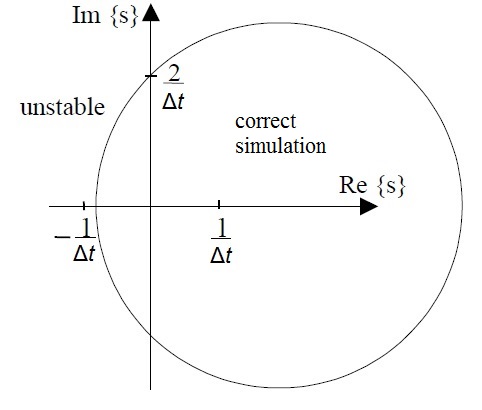This is an old revision of this page, as edited by 108.169.156.10 (talk) at 17:15, 6 July 2018 (→Corrected sign error in energy functional.). The present address (URL) is a permanent link to this revision, which may differ significantly from the current revision.
Revision as of 17:15, 6 July 2018 by 108.169.156.10 (talk) (→Corrected sign error in energy functional.)(diff) ← Previous revision | Latest revision (diff) | Newer revision → (diff)In mathematics, the semi-implicit Euler method, also called symplectic Euler, semi-explicit Euler, Euler–Cromer, and Newton–Størmer–Verlet (NSV), is a modification of the Euler method for solving Hamilton's equations, a system of ordinary differential equations that arises in classical mechanics. It is a symplectic integrator and hence it yields better results than the standard Euler method.
Setting
The semi-implicit Euler method can be applied to a pair of differential equations of the form
where f and g are given functions. Here, x and v may be either scalars or vectors. The equations of motion in Hamiltonian mechanics take this form if the Hamiltonian is of the form
The differential equations are to be solved with the initial condition
The method
The semi-implicit Euler method produces an approximate discrete solution by iterating
where Δt is the time step and tn = t0 + nΔt is the time after n steps.
The difference with the standard Euler method is that the semi-implicit Euler method uses vn+1 in the equation for xn+1, while the Euler method uses vn.
Applying the method with negative time step to the computation of from and rearranging leads to the second variant of the semi-implicit Euler method
which has similar properties.
The semi-implicit Euler is a first-order integrator, just as the standard Euler method. This means that it commits a global error of the order of Δt. However, the semi-implicit Euler method is a symplectic integrator, unlike the standard method. As a consequence, the semi-implicit Euler method almost conserves the energy (when the Hamiltonian is time-independent). Often, the energy increases steadily when the standard Euler method is applied, making it far less accurate.
Alternating between the two variants of the semi-implicit Euler method leads in one simplification to the Störmer-Verlet integration and in a slightly different simplification to the leapfrog integration, increasing both the order of the error and the order of preservation of energy.
The stability region of the semi-implicit method was presented by Niiranen although the semi-implicit Euler was misleadingly called symmetric Euler in his paper. The semi-implicit method models the simulated system correctly if the complex roots of the characteristic equation are within the circle shown below. For real roots the stability region extends outside the circle for which the criteria is
As can be seen, the semi-implicit method can simulate correctly both stable systems that have their roots in the left half plane and unstable systems that have their roots in the right half plane. This is clear advantage over forward (standard) Euler and backward Euler. Forward Euler tends to have less damping than the real system when the negative real parts of the roots get near the imaginary axis and backward Euler may show the system be stable even when the roots are in the right half plane.
Example
The motion of a spring satisfying Hooke's law is given by
The semi-implicit Euler for this equation is
The iteration preserves the modified energy functional exactly, leading to stable periodic orbits (for sufficiently small step size) that deviate by from the exact orbits. The exact circular frequency increases in the numerical approximation by a factor of .
References
- Hairer, Ernst; Lubich, Christian; Wanner, Gerhard (2003). "Geometric numerical integration illustrated by the Störmer/Verlet method". Acta Numerica. 12: 399–450. doi:10.1017/S0962492902000144.
- Niiranen, Jouko: Fast and accurate symmetric Euler algorithm for electromechanical simulations Proceedings of the Electrimacs'99, Sept. 14-16, 1999 Lisboa, Portugal, Vol. 1, pages 71 - 78.
- Giordano, Nicholas J.; Hisao Nakanishi (July 2005). Computational Physics (2nd ed.). Benjamin Cummings. ISBN 0-13-146990-8.
- MacDonald, James. "The Euler-Cromer method". University of Delaware. Retrieved 2013-04-11.
- Vesely, Franz J. (2001). Computational Physics: An Introduction (2nd ed.). Springer. p. 117. ISBN 978-0-306-46631-1.
| Numerical methods for ordinary differential equations | |
|---|---|
| First-order methods | |
| Second-order methods | |
| Higher-order methods | |
| Theory | |





 from
from  and rearranging leads to the second variant of the semi-implicit Euler method
and rearranging leads to the second variant of the semi-implicit Euler method





 exactly, leading to stable periodic orbits (for sufficiently small step size) that deviate by
exactly, leading to stable periodic orbits (for sufficiently small step size) that deviate by  from the exact orbits. The exact circular frequency
from the exact orbits. The exact circular frequency  increases in the numerical approximation by a factor of
increases in the numerical approximation by a factor of  .
.